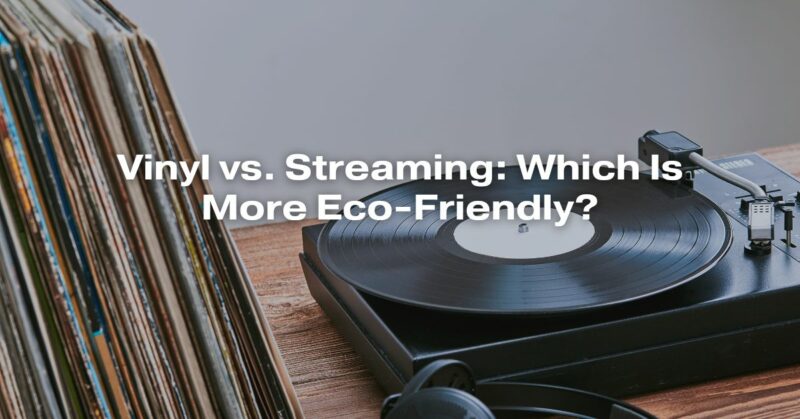In an era marked by increasing environmental consciousness, the impact of our choices on the planet has never been more important. From the food we eat to the transportation we use, people are striving to make eco-friendly choices in every aspect of their lives. This extends to the world of music consumption, where the debate between vinyl records and streaming services has taken on a new dimension. Both vinyl records and streaming have their unique environmental footprints, and understanding the ecological implications of each can help individuals make more informed decisions about their music consumption habits.
The Resurgence of Vinyl
Vinyl records, once considered a relic of the past, have experienced a remarkable resurgence in recent years. Audiophiles and music enthusiasts alike have been drawn to the warm, analog sound of vinyl, the tactile experience of handling records, and the visual appeal of album art. However, the production and use of vinyl records have both positive and negative environmental aspects.
The Production Process
Vinyl records are made from polyvinyl chloride (PVC), a type of plastic. The manufacturing process of PVC involves the extraction of chlorine gas, which is a hazardous substance. The production of PVC also consumes significant energy, contributing to greenhouse gas emissions. Additionally, the process of pressing vinyl records involves various chemicals, including solvents and inks, which can have adverse environmental effects if not managed properly.
On the bright side, vinyl records are exceptionally durable and can last for decades if properly cared for. This longevity can reduce the need for frequent replacements and diminish the overall demand for new vinyl production.
The Lifecycle
When discussing the eco-friendliness of vinyl, it’s essential to consider the entire lifecycle of a record. Vinyl records are physical objects, and their creation, distribution, and disposal all have environmental implications. For example, shipping vinyl records in heavy, protective packaging can increase their carbon footprint due to transportation costs. On the other hand, vinyl records can be recycled and repurposed, further extending their lifespan and reducing waste.
The Rise of Music Streaming
Streaming services have revolutionized the way people consume music. With the click of a button, users have access to vast libraries of music from around the world. This convenience has led to the rapid growth of streaming platforms, but it also comes with its own set of environmental challenges.
Data Centers and Energy Consumption
The backbone of music streaming lies in data centers, which host the vast databases of songs and handle the streaming requests from users. These data centers require an enormous amount of energy to operate efficiently. The servers and cooling systems necessary to keep these facilities running 24/7 contribute to a substantial carbon footprint. Moreover, as streaming services continue to grow, so does their energy consumption.
Device Production and E-waste
Another aspect of streaming’s environmental impact relates to the devices used for playback. Smartphones, tablets, laptops, and smart speakers all contribute to the energy and resource-intensive electronics industry. The constant production and disposal of electronic devices generate e-waste, which poses significant environmental and health risks when not managed properly.
Comparing the Eco-Friendliness
When comparing vinyl records and streaming services from an eco-friendly perspective, several factors must be considered:
1. Energy Consumption
Both vinyl production and streaming services have energy-related environmental costs. While vinyl production consumes energy in manufacturing and transportation, streaming relies heavily on data centers, which are energy-intensive. The overall impact depends on factors such as the source of energy and the efficiency of the production and distribution processes.
2. Longevity
Vinyl records have the advantage of lasting for decades, reducing the need for frequent replacements. Streaming, on the other hand, relies on electronic devices that may have shorter lifespans. This means that the continued production and disposal of devices can contribute to electronic waste.
3. Packaging and Transportation
Vinyl records often require protective packaging, which can contribute to their carbon footprint during transportation. Streaming eliminates physical distribution, reducing the environmental impact associated with shipping and packaging.
4. Resource Use
Vinyl records are made from PVC, a type of plastic that has its own environmental concerns, including chemical extraction and production. Streaming relies on electronic devices that require metals and minerals, contributing to resource extraction and mining-related environmental issues.
5. E-waste vs. Physical Waste
While vinyl records can be recycled and repurposed, streaming services generate electronic waste when devices reach the end of their life cycle. Proper disposal and recycling of electronic devices are essential to mitigate this environmental impact.
Conclusion
The comparison between vinyl records and streaming services in terms of eco-friendliness is complex and multifaceted. Each has its unique set of environmental advantages and drawbacks. To make more sustainable choices, consumers should consider factors such as energy consumption, longevity, packaging, resource use, and waste generation.
Ultimately, the choice between vinyl and streaming depends on personal preferences, values, and priorities. Some may prefer the tactile experience and nostalgia of vinyl records despite their production-related challenges, while others may prioritize the convenience and reduced physical waste associated with streaming. Regardless of the choice made, individuals can take steps to reduce their environmental impact, such as supporting sustainable vinyl production practices or choosing energy-efficient streaming services and devices. In the end, the key to a more eco-friendly music consumption habit lies in awareness and informed decision-making.


